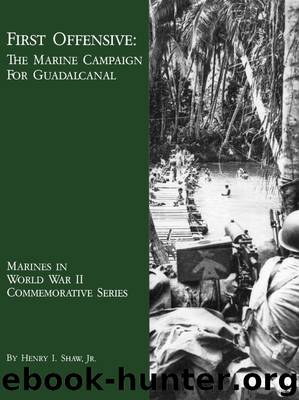First Offensive: The Marine Campaign for Guadalcanal by Henry I. Shaw

Author:Henry I. Shaw [Shaw, Henry I.]
Language: eng
Format: epub
Tags: Guadalcanal, Battle of, Solomon Islands, 1942-1943, United States. Marine Corps -- History -- World War, 1939-1945, Vandegrift, A. A. (Alexander Archer), 1887-1973
Published: 2015-04-26T16:00:00+00:00
More than 200 Japanese soldiers alone were killed in a frenzied attack in the sandspit where the Tenaru River flows into Ironbottom Sound (Sealark Channel).
On the 9th, Whaling’s force, flanked by the 2d and then the 1st Battalion, 7th Marines, crossed the Matanikau and then turned and followed ridge lines to the sea. Puller’s battalion discovered a number of Japanese in a ravine to his front, fired his mortars, and called in artillery, while his men used rifles and machine guns to pick off enemy troops trying to escape what proved to be a death trap. When his mortar ammunition began to run short, Puller moved on toward the beach, joining the rest of Whaling’s force, which had encountered no opposition. The Marines then recrossed the Mantanikau, joined Edson’s troops, and marched back to the perimeter, leaving a strong combat outpost at the Matanikau, now cleared of Japanese. General Vandegrift, apprised by intelligence sources that a major Japanese attack was coming from the west, decided to consolidate his positions, leaving no sizable Marine force more than a day’s march from the perimeter. The Marine advance on 7–9 October had thwarted Japanese plans for an early attack and cost the enemy more than 700 men. The Marines paid a price too, 65 dead and 125 wounded.
There was another price that Guadalcanal was exacting from both sides. Disease was beginning to fell men in numbers that equalled the battle casualties. In addition to gastroenteritis, which greatly weakened those who suffered its crippling stomach cramps, there were all kinds of tropical fungus infections, collectively known as “jungle rot,” which produced uncomfortable rashes on men’s feet, armpits, elbows, and crotches, a product of seldom being dry. If it didn’t rain, sweat provided the moisture. On top of this came hundreds of cases of malaria. Atabrine tablets provided some relief, besides turning the skin yellow, but they were not effective enough to stop the spread of the mosquito-borne infection. Malaria attacks were so pervasive that nothing short of complete prostration, becoming a litter case, could earn a respite in the hospital. Naturally enough, all these diseases affected most strongly the men who had been on the island the longest, particularly those who experienced the early days of short rations. Vandegrift had already argued with his superiors that when his men eventually got relieved they should not be sent to another tropical island hospital, but rather to a place where there was a real change of atmosphere and climate. He asked that Auckland or Wellington, New Zealand, be considered.
For the present, however, there was to be no relief for men starting their third month on Guadalcanal. The Japanese would not abandon their plan to seize back Guadalcanal and gave painful evidence of their intentions near mid-October. General Hyakutake himself landed on Guadalcanal on 7 October to oversee the coming offensive. Elements of Major General Masao Maruyama’s Sendai Division, already a factor in the fighting near the Matanikau, landed with him. More men were coming. And the
Download
This site does not store any files on its server. We only index and link to content provided by other sites. Please contact the content providers to delete copyright contents if any and email us, we'll remove relevant links or contents immediately.
The Radium Girls by Kate Moore(10903)
The Templars by Dan Jones(4182)
100 Deadly Skills by Clint Emerson(4072)
Rise and Kill First by Ronen Bergman(4009)
The Doomsday Machine by Daniel Ellsberg(3726)
The Rape of Nanking by Iris Chang(3508)
Killing England by Bill O'Reilly(3451)
Hitler in Los Angeles by Steven J. Ross(3431)
Stalin by Stephen Kotkin(3082)
12 Strong by Doug Stanton(3052)
Hitler's Monsters by Eric Kurlander(2729)
Darkest Hour by Anthony McCarten(2643)
Blood and Sand by Alex Von Tunzelmann(2606)
The Art of War Visualized by Jessica Hagy(2410)
Hitler's Flying Saucers: A Guide to German Flying Discs of the Second World War by Stevens Henry(2290)
The Code Book by Simon Singh(2205)
The Second World Wars by Victor Davis Hanson(2131)
Babylon's Ark by Lawrence Anthony(2066)
Tobruk by Peter Fitzsimons(2055)
